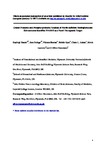Global Proteome and Phospho-proteome Analysis of Merlin-deficient Meningioma and Schwannoma Identifies PDLIM2 as a Novel Therapeutic Target
| dc.contributor.author | Bassiri, K | |
| dc.contributor.author | Ferluga, Sara | |
| dc.contributor.author | Sharma, Vikram | |
| dc.contributor.author | Syed, N | |
| dc.contributor.author | Adams, Claire | |
| dc.contributor.author | Lasonder, Edwin | |
| dc.contributor.author | Hanemann, Clemens Oliver | |
| dc.date.accessioned | 2017-03-10T16:50:04Z | |
| dc.date.available | 2017-03-10T16:50:04Z | |
| dc.date.issued | 2017-02-01 | |
| dc.identifier.issn | 2352-3964 | |
| dc.identifier.issn | 2352-3964 | |
| dc.identifier.uri | http://hdl.handle.net/10026.1/8608 | |
| dc.description.abstract |
Loss or mutation of the tumour suppressor Merlin predisposes individuals to develop multiple nervous system tumours, including schwannomas and meningiomas, sporadically or as part of the autosomal dominant inherited condition Neurofibromatosis 2 (NF2). These tumours display largely low grade features but their presence can lead to significant morbidity. Surgery and radiotherapy remain the only treatment options despite years of research, therefore an effective therapeutic is required. Unbiased omics studies have become pivotal in the identification of differentially expressed genes and proteins that may act as drug targets or biomarkers. Here we analysed the proteome and phospho-proteome of these genetically defined tumours using primary human tumour cells to identify upregulated/activated proteins and/or pathways. We identified over 2000 proteins in comparative experiments between Merlin-deficient schwannoma and meningioma compared to human Schwann and meningeal cells respectively. Using functional enrichment analysis we highlighted several dysregulated pathways and Gene Ontology terms. We identified several proteins and phospho-proteins that are more highly expressed in tumours compared to controls. Among proteins jointly dysregulated in both tumours we focused in particular on PDZ and LIM domain protein 2 (PDLIM2) and validated its overexpression in several tumour samples, while not detecting it in normal cells. We showed that shRNA mediated knockdown of PDLIM2 in both primary meningioma and schwannoma leads to significant reductions in cellular proliferation. To our knowledge, this is the first comprehensive assessment of the NF2-related meningioma and schwannoma proteome and phospho-proteome. Taken together, our data highlight several commonly deregulated factors, and indicate that PDLIM2 may represent a novel, common target for meningioma and schwannoma. | |
| dc.format.extent | 76-86 | |
| dc.format.medium | Print-Electronic | |
| dc.language | en | |
| dc.language.iso | en | |
| dc.publisher | Elsevier BV | |
| dc.subject | Meningioma | |
| dc.subject | Schwannoma | |
| dc.subject | NF2 | |
| dc.subject | Merlin | |
| dc.subject | Proteome | |
| dc.subject | Phospho-proteome | |
| dc.title | Global Proteome and Phospho-proteome Analysis of Merlin-deficient Meningioma and Schwannoma Identifies PDLIM2 as a Novel Therapeutic Target | |
| dc.type | journal-article | |
| dc.type | Journal Article | |
| plymouth.author-url | https://www.webofscience.com/api/gateway?GWVersion=2&SrcApp=PARTNER_APP&SrcAuth=LinksAMR&KeyUT=WOS:000395262400020&DestLinkType=FullRecord&DestApp=ALL_WOS&UsrCustomerID=11bb513d99f797142bcfeffcc58ea008 | |
| plymouth.volume | 16 | |
| plymouth.publication-status | Published | |
| plymouth.journal | EBioMedicine | |
| dc.identifier.doi | 10.1016/j.ebiom.2017.01.020 | |
| plymouth.organisational-group | /Plymouth | |
| plymouth.organisational-group | /Plymouth/Faculty of Health | |
| plymouth.organisational-group | /Plymouth/Faculty of Health/Peninsula Medical School | |
| plymouth.organisational-group | /Plymouth/Faculty of Health/School of Biomedical Sciences | |
| plymouth.organisational-group | /Plymouth/REF 2021 Researchers by UoA | |
| plymouth.organisational-group | /Plymouth/REF 2021 Researchers by UoA/UoA01 Clinical Medicine | |
| plymouth.organisational-group | /Plymouth/REF 2021 Researchers by UoA/UoA01 Clinical Medicine/UoA01 Clinical Medicine | |
| plymouth.organisational-group | /Plymouth/Research Groups | |
| plymouth.organisational-group | /Plymouth/Research Groups/Institute of Translational and Stratified Medicine (ITSMED) | |
| plymouth.organisational-group | /Plymouth/Research Groups/Institute of Translational and Stratified Medicine (ITSMED)/CBR | |
| plymouth.organisational-group | /Plymouth/Research Groups/Plymouth Institute of Health and Care Research (PIHR) | |
| plymouth.organisational-group | /Plymouth/Users by role | |
| plymouth.organisational-group | /Plymouth/Users by role/Academics | |
| plymouth.organisational-group | /Plymouth/Users by role/Researchers in ResearchFish submission | |
| dc.publisher.place | Netherlands | |
| dcterms.dateAccepted | 2017-01-13 | |
| dc.identifier.eissn | 2352-3964 | |
| dc.rights.embargoperiod | Not known | |
| rioxxterms.versionofrecord | 10.1016/j.ebiom.2017.01.020 | |
| rioxxterms.licenseref.uri | http://www.rioxx.net/licenses/all-rights-reserved | |
| rioxxterms.licenseref.startdate | 2017-02-01 | |
| rioxxterms.type | Journal Article/Review | |
| plymouth.oa-location | http://www.sciencedirect.com/science/article/pii/S2352396417300245?via=ihub |


